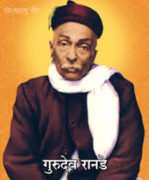By Dr. G.R. Vijayakumar
 Just after the conclusion of the All India Sai Devotees’ Convention at Hubli-Dharwar (Karnataka, India) in 1952, both Sri Narasimha Swamiji and Sri Radhakrishna Swamiji visited the Nimbal Ashram, near Sholapur, to meet Gurudev Ranade of the Navnath Sampradaya. Here Sri Narasimha Swamiji exclaimed, “The sacredness of this place reverberating with Divine Name and the presence of Ranade awakens divinity.” Much later in 1987, when I visited this Ashram, the words ‘Narayana, Narayana’ emerged automatically from Gurudev Ranade’s Samadhi. Indeed, Nimbal Ashram is one place where aspirants can rush to attain God, vision, peace and tranquility.
Just after the conclusion of the All India Sai Devotees’ Convention at Hubli-Dharwar (Karnataka, India) in 1952, both Sri Narasimha Swamiji and Sri Radhakrishna Swamiji visited the Nimbal Ashram, near Sholapur, to meet Gurudev Ranade of the Navnath Sampradaya. Here Sri Narasimha Swamiji exclaimed, “The sacredness of this place reverberating with Divine Name and the presence of Ranade awakens divinity.” Much later in 1987, when I visited this Ashram, the words ‘Narayana, Narayana’ emerged automatically from Gurudev Ranade’s Samadhi. Indeed, Nimbal Ashram is one place where aspirants can rush to attain God, vision, peace and tranquility.
Ramachandra Dattatreya Ranade, known all over the world as Gurudev Ranade, whose pre-monastic name was Rambhau, was one of the foremost spiritual leaders of modern India who dedicated his life for the spiritual upliftment of millions. Considered in the lineage of Sri Nimbargi Maharaj (1789-1875) and Sri Bhausaheb Maharaj (1843-1914) of the Navanth Sampradya, he was a great saint, making the mystic teachings of India available to the world through his profound experience and study of the poet saints of Maharashtra and Karnataka. He travelled all over the country preaching ‘Bhakti Marg’ – initiating many sadhakas with ‘Nama mantra.’ He made devotees look at the illuminated vision of God and meditate silently on His name even when they are busy in doing other activities.
He was born in Jamakhandi, Bijapur District of Karnataka on July 3, 1886. After completing his schooling, he studied at the Deccan College, Pune. In 1901, he was saved from drowning by his friend Kallu Bokhare who also took him to his Guru, Bhausaheb Maharaj. The great Guru brought a spiritual transformation in young Ranade. He blessed him with two rupees and advised him to use one for the ‘prapancha’ and the second for his ‘paramartha.’ Ranade asked, “Can the worldly life be made happy by meditation?” The Guru’s reply was, “Nothing is impossible for God.”
In 1914 he passed M.A. with two Gold Medals and joined the teaching staff of the Fergusson College, Pune, and then at the Willingdon College, Sangli. Later he joined Allahabad University in the department of Philosophy where he rose to become a Professor, Dean and retired as Vice-Chancellor.
In 1920, on a visit to Benares he happened to hear in the Shankar Math the song of devotion, “Bhaja Govindam: Be devoted to Lord Govinda – a lesson in Grammar will not save you when the death is at hand.” This gave him the impetus to make a thorough study of Indian philosophy and mysticism as taught by the saints of India. He wrote meticulous books on Indian mystics and their philosophy with informative comparisons to the great mystic traditions. He articulated the teachings of Jnanadev, Nivrittinath, Eknath and Muktabai, as well as the teachings of Tukaram. His monumental work is ‘A constructive survey of Upanishadic philosophy’ in 1926. He wrote ‘Pathways to God’ in Marathi and Hindi. He practiced teachings of Shirdi Sai Baba.
Sri Narasimha Swamiji’s biography on Ramana Bhagwan directed Gurudev Ranade to Tiruvannamalai to meet Ramana. Both Ramana Bhagwan and Nisargadatta Maharaj influenced his spiritual thinking. He also met Annie Besant who recognized his high caliber, but he declined to join the world-wide Theosophical Society Movement. Instead, he created ‘Adhyatma Vidyapeeta’ for Comparative Philosophy and Religion’ in Belgaum.
Ranade had his share of troubles in life, the loss of a child, his wife and his mother. Even then, he prayed to God, “You and I shall now live together.” He also struggled with health problems for much of his life, but he cared for and struggled for the highest good of all those who approached him. He developed great dispassion and renunciation right after his Guru’s initiation.
In 1921, Ranade was looking for a place near his Guru’s Samadhi. He had a vision of a tall person standing before him who said ‘Nimbargi Maharaj has gone to Nimbal.’ The vision ended and the next day Ranade could buy 48 acres of land near Nimbal Railway station. He built an ashram there and lived there after his retirement. He had the vision of God in every nook and corner of that ashram.
He cast off his mortal coil on the 6 th of June 1957. A living tradition continues in Maharashtra due to the devotees of Guru Ranade, with centers and temples which actively function with a rich tradition of Guru Bhakti, meditation and Nama yoga.

Leave a Reply